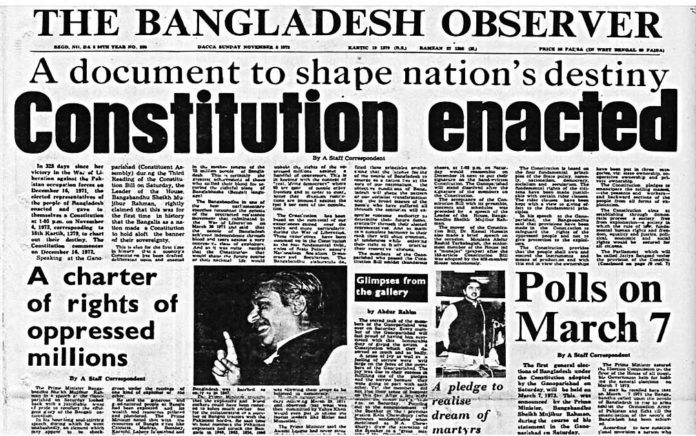The Constitution of Bangladesh is the supreme law of the country, and it came into effect on December 16, 1972, replacing the previous Government of India Act, 1935. The Constitution consists of a preamble and 11 parts, containing a total of 153 articles.
The history of the Constitution of Bangladesh dates back to the country’s struggle for independence from Pakistan in 1971. Following the liberation war, the provisional government of Bangladesh promulgated the first Constitution of the country, known as the “Provisional Constitution of Bangladesh Order, 1972”, on April 10, 1972.
This provisional constitution was later replaced by the “Constitution of the People’s Republic of Bangladesh”, which was adopted on November 4, 1972, and came into effect on December 16, 1972. The Constitution was framed by a Constituent Assembly, which was elected in 1970, but the Assembly was unable to complete the task due to the outbreak of the liberation war.
The Constitution of Bangladesh underwent several amendments over the years, with the first amendment being made in 1973, followed by amendments in 1974, 1979, 1986, 1988, 1991, 1996, 2004, 2011, and 2014. The most significant of these amendments were made in 1974, which declared Bangladesh as a socialist state, and in 1991, which restored the parliamentary system of government in the country.
The background of the Constitution of Bangladesh can be traced back to the country’s struggle for independence from Pakistan in 1971. The Pakistani government, led by General Yahya Khan, refused to recognize the results of the 1970 general election in which the Awami League, led by Sheikh Mujibur Rahman, won a clear majority in the National Assembly of Pakistan. The refusal to transfer power to the elected representatives of East Pakistan (now Bangladesh) led to a widespread civil disobedience movement, and eventually, a liberation war broke out between East Pakistan and West Pakistan.
After a nine-month-long war, Bangladesh achieved independence on December 16, 1971. A provisional government was formed, and preparations began for the framing of a constitution for the new nation. In 1972, a Constituent Assembly was elected to draft the Constitution of Bangladesh.
The Constitution was drafted in the context of political and social transformation. Bangladesh was struggling to recover from the devastation of war, and the Constitution aimed to provide a framework for a democratic, socialist, and secular state. The Constitution was heavily influenced by the ideology of the ruling party, the Awami League, which had a socialist and secular vision for the country.
The Constitution was framed with the goal of creating a society based on justice, equality, and human dignity and providing protection to the fundamental rights of the citizens. It declared Bangladesh a parliamentary democracy with a strong emphasis on social justice, economic development, and national unity.
The Constitution also recognized the importance of local governance and established a system of local government at the district and village levels. It provided for the establishment of an independent judiciary and an Election Commission to oversee the conduct of free and fair elections.
The Constitution of Bangladesh was suspended twice in the country’s history. The first time was in 1975 when the military government of General Ziaur Rahman suspended the Constitution and promulgated a new one. The second time was in 2007 when the military government of General Moeen U Ahmed declared a state of emergency and suspended the Constitution.
However, after the restoration of democracy in 2009, the Constitution was reinstated, and the government made efforts to strengthen the democratic institutions in the country. Today, the Constitution of Bangladesh is considered one of the most progressive constitutions in South Asia, providing a framework for a democratic, secular, and inclusive society.
Some of the key features of the Constitution of Bangladesh are:
Parliamentary system: Bangladesh has a parliamentary system of government, with the President as the head of state and the Prime Minister as the head of government.
Fundamental rights: The Constitution guarantees fundamental rights to every citizen, including the right to life, liberty, and the pursuit of happiness, the freedom of speech, religion, assembly, and association, and the right to a fair trial.
Separation of powers: The Constitution establishes three separate branches of government – the Executive, the Legislature, and the Judiciary – and provides for a system of checks and balances to prevent any one branch from becoming too powerful.
Local government: The Constitution provides for a system of local government at the district and village levels, with elected representatives responsible for governing these areas.
Islam as the state religion: The Constitution declares Islam as the state religion of Bangladesh, but also recognizes the rights of minorities to practice their own religion.
National symbols: The Constitution recognizes several national symbols of Bangladesh, including the national flag, the national anthem, and the national emblem.
Overall, the Constitution of Bangladesh provides a framework for the governance of the country and establishes the basic rights and freedoms of its citizens.
